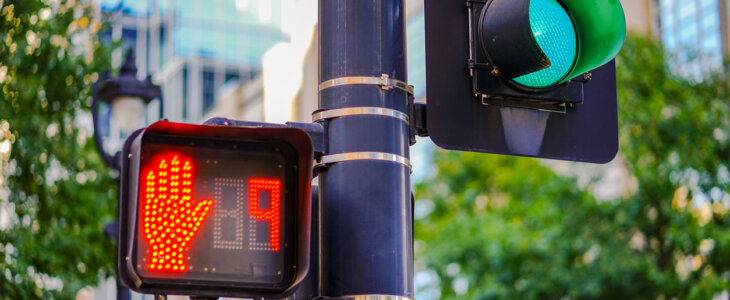Like New York City, San Francisco has committed itself to “Vision Zero,” a safety campaign that aims to completely eliminate traffic deaths in the city by 2024. While a lot of progress has been made toward this goal, it’s worth examining which safety measures are most effective and which could be improved. With that in mind, here are three small changes that could help prevent further pedestrian accidents.
STRIPED CROSSWALKS
Many marked crosswalks throughout the Bay Area are simple white lines directing a path across the road. It’s tempting to think pedestrian crashes can be reduced by marking these crosswalks and surrounding curbs with reflective yellow paint. After all, California school zones are required to have neon yellow markings as a means of improving visibility. However, a study for the Federal Highway Administration found “little evidence” that yellow crosswalks are more visible than white ones.
Although a simple marked crosswalk alone may not be sufficient to reduce pedestrian accidents, the San Francisco Municipal Transportation Agency (SFMTA) claims that zebra-striped crosswalks are significantly more effective at getting drivers to yield, which is why they’ve made a goal of replacing all of the city’s standard crosswalks with striped ones. However, even six years after announcing that goal, there are still a lot of crosswalks in need of overhaul, and neighboring cities of the Bay Area aren’t keeping up with the same goals.
Of course, street markings are just one part of the equation. Ideally, a crosswalk should be marked, start at a raised curb, have a raised median in the middle (when applicable), have traffic signals for both cars and pedestrians, and have enough lighting that the pedestrian is clearly visible when crossing at night.
ELIMINATE CROSSWALK BUTTONS
Crosswalk buttons can be frustrating. The majority of them don’t do anything, and others only allow pedestrians to cross when someone pushes the button. This leads some pedestrians to incorrectly believe the crosswalk signals are broken and that they need to cross on their own.
Not only is this dangerous jaywalking, but it also significantly increases the risk of a crash at busy intersections because the pedestrian may noy be able to see all the traffic signals at once. They may not know when someone will turn right against a red light or who has a protected left turn. Additionally, visually impaired pedestrians have no way to know whether they need to press the “beg button” to cross the street.
The increased risks associated with crosswalk buttons have been known for decades, but little changed until it came to COVID-related health consciousness. Now, San Francisco and parts of Los Angeles are covering crosswalk buttons and replacing them with automated pedestrian detection systems. Again, it will need to be a comprehensive effort; real impact comes about when improved safety features are distributed across the entire Bay Area.
REPLACE COUNTDOWN TIMERS?
Countdown timers are widely considered to be a great thing for pedestrian safety. They let people know when it’s safe to walk and tell them how much time they have left. However, what is good for pedestrians may not be good for traffic safety.
When drivers can see that countdown clock, they may be less likely to slow down for a yellow light. Many drivers try to time their movement so they can either drive through an intersection before it turns red or catch the green light before they come to a stop. However, drivers at the intersecting street are doing this as well. This, in turn, creates speeding issues and infrequent yielding at intersections with visible countdown timers.
One traffic study conducted in Toronto found that countdown timers were effective at reducing pedestrian crashes (saving 5 lives in a month), but that car crashes significantly increased at these same intersections (increasing by 22 crashes in a month). These crashes were often much more severe as drivers tended to be speeding, and the crashes were side-impact (T-bones) which tend to cause much more serious injuries. If the crash is particularly severe, it may cause collateral damage, injuring nearby pedestrians and other drivers.
In response to these issues, some traffic engineers have suggested replacing visual countdown timers with a vocal countdown only audible to nearby pedestrians. However, just as modern “beg buttons” alienate the visually impaired, this new system could negatively impact the hearing impaired.
While countdown timers demonstrably reduce pedestrian crashes, it’s clear they’re less than ideal. Next time you see the clock ticking, whether you’re a driver or a pedestrian, remember to stay cautious and watch out for hazards, particularly on the cross streets.
To schedule a free case consultation with an experienced Walnut Creek personal injury attorney from Casper, Meadows, Schwartz & Cook, please don’t hesitate to give us a call at (925) 275-5592 or send us an email.

